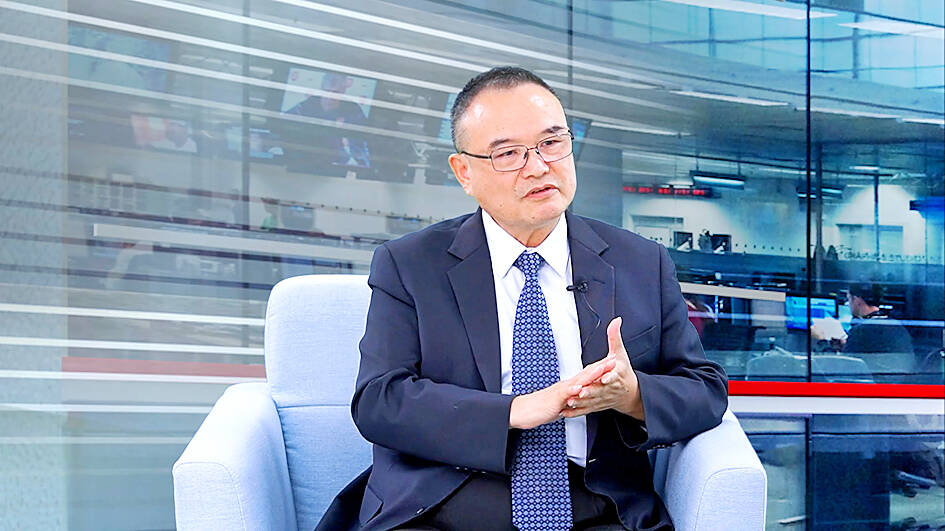Taiwan’s National Palace Museum (NPM) is not ruling out collaborating with the museums in Beijing and Hong Kong if both sides of the Strait can approach cross-strait issues “more wisely,” museum director Hsiao Tsung-huang (蕭宗煌) said on Friday.
The Palace Museum in Beijing, the Hong Kong Palace Museum, and the NPM have different developmental directions and goals, but ultimately “we’re all working hard to preserve the cultural artifacts of the Huaxia (華夏) culture,” Hsiao told the Chinese-language Liberty Times (the Taipei Times’ sister newspaper) in an exclusive interview.
“We do not have certain ideologies. Absolutely not,” he said, adding that he is very much looking forward to the day that the palace museums in Beijing, Taiwan and Hong Kong could work together and jointly curator an exhibition.

Photo: Ling Mei-hsueh, Taipei Times
Hsiao said that since the collection of artifacts was relocated to Taiwan in 1948-1949, it has largely been incorporated as part of Taiwanese culture, and that incorporation began when “our past textbooks normalized the visitation of the National Palace Museum.”
The National Palace Museum Southern Branch is an example of Taiwanese society’s acceptance of its exhibitions, he said.
The southern branch was initially designated as a museum of Asia, and planned to feature mainly works from other parts of the continent, while avoiding exhibiting works from the museum’s northern branch, Hsiao said, adding that government officials and Chiayi County locals wanted to see works from the northern branch.
“It might be difficult for art, culture or museums to remain uninfluenced by politics, but they are fundamentally different things,” he said.
While the museum greatly suffered from a lack of tourists during the COVID-19 pandemic, it achieved the goal of attracting 1 million visitors to each branch this month, Hsiao said.
The museums are hosting a series of exhibitions in the second half of the year, including a culture and art exhibition about the Age of Exploration and an ancient bronze weapons exhibition in December, he said.
From Jan. 1 to early last month, the northern branch of the museum had had about 800,000 visitors, he said, adding that the museum on average receives about 100,000 visitors per month.
The museum administration makes a great effort to maximize the interest of younger visitors and encourage them to visit the two branches, Hsiao said.
Giving Northern Song Dynasty (960 to 1127) piece Travelers Among Mountains and Streams (谿山行旅圖) by Fan Kuan as an example, Hsiao said children would only see it as “a dark blob” and quickly lose interest.
The museum introduced a digital exhibition feature, in which visitors can view the work and have a bird’s eye view of the mountains and the travelers on the mountain paths, which might greatly increase children’s interest in revisiting the art piece, he said.

ANOTHER EMERGES: The CWA yesterday said this year’s fourth storm of the typhoon season had formed in the South China Sea, but was not expected to affect Taiwan Tropical Storm Gaemi has intensified slightly as it heads toward Taiwan, where it is expected to affect the country in the coming days, the Central Weather Administration (CWA) said yesterday. As of 8am yesterday, the 120km-radius storm was 800km southeast of Oluanpi (鵝鑾鼻), Taiwan’s southernmost tip, moving at 9kph northwest, the agency said. A sea warning for Gaemi could be issued tonight at the earliest, it said, adding that the storm is projected to be closest to Taiwan on Wednesday or Thursday. Gaemi’s potential effect on Taiwan remains unclear, as that would depend on its direction, radius and intensity, forecasters said. Former Weather Forecast

As COVID-19 cases in Japan have been increasing for 10 consecutive weeks, people should get vaccinated before visiting the nation, the Centers for Disease Control (CDC) said. The centers reported 773 hospitalizations and 124 deaths related to COVID-19 in Taiwan last week. CDC Epidemic Intelligence Center Director Guo Hung-wei (郭宏偉) on Tuesday said the number of weekly COVID-19 cases reported in Japan has been increasing since mid-May and surpassed 55,000 cases from July 8 to July 14. The average number of COVID-19 patients at Japan’s healthcare facilities that week was also 1.39 times that of the week before and KP.3 is the dominant

The Chinese Communist Party’s (CCP) working group for Taiwan-related policies is likely to be upgraded to a committee-level body, a report commissioned by the Mainland Affairs Council (MAC) said. As Chinese President Xi Jinping (習近平) is increasingly likely to upgrade the CCP’s Central Leading Group for Taiwan Affairs, Taiwanese authorities should prepare by researching Xi and the CCP, the report said. At the third plenary session of the 20th Central Committee of the CCP, which ended on Thursday last week, the party set a target of 2029 for the completion of some tasks, meaning that Xi is likely preparing to

US-CHINA TRADE DISPUTE: Despite Beijing’s offer of preferential treatment, the lure of China has dimmed as Taiwanese and international investors move out Japan and the US have become the favored destinations for Taiwanese graduates as China’s attraction has waned over the years, the Ministry of Labor said. According to the ministry’s latest income and employment advisory published this month, 3,215 Taiwanese university graduates from the class of 2020 went to Japan, surpassing for the first time the 2,881 graduates who went to China. A total of 2,300 graduates from the class of 2021 went to the US, compared with the 2,262 who went to China, the document showed. The trend continued for the class of 2023, of whom 1,460 went to Japan, 1,334 went to